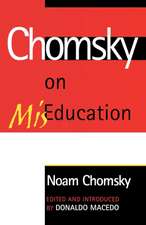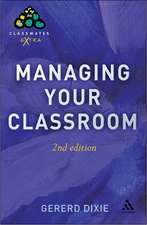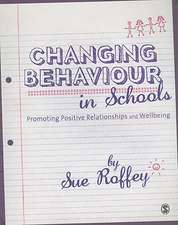Mining Complex Text, Grades 2-5: Using and Creating Graphic Organizers to Grasp Content and Share New Understandings: Corwin Literacy
Autor Diane K. Lapp, Thomas DeVere Wolsey, Karen D. Wooden Limba Engleză Paperback – 16 dec 2014
Now more than ever, our students are being asked to do highly advanced thinking, talking, and writing around their reading. If only there were ingenious new tools that could give our students the space to tease apart complex ideas in order to comprehend and weld their understandings into a new whole. Good news: these tools exist—Mining Complex Text. You’ll learn how graphic organizers can:
- Help students read, reread, and take notes on a text
- Promote students’ oral sharing of information and their ideas
- Elevate organized note-making from complex text(s)
- Scaffold students’ narrative and informational writing
Din seria Corwin Literacy
-
 Preț: 285.18 lei
Preț: 285.18 lei -
 Preț: 158.08 lei
Preț: 158.08 lei -
 Preț: 278.41 lei
Preț: 278.41 lei -
 Preț: 243.82 lei
Preț: 243.82 lei -
 Preț: 244.25 lei
Preț: 244.25 lei -
 Preț: 88.42 lei
Preț: 88.42 lei -
 Preț: 273.64 lei
Preț: 273.64 lei -
 Preț: 274.70 lei
Preț: 274.70 lei -
 Preț: 200.92 lei
Preț: 200.92 lei -
 Preț: 248.27 lei
Preț: 248.27 lei -
 Preț: 284.26 lei
Preț: 284.26 lei -
 Preț: 294.79 lei
Preț: 294.79 lei -
 Preț: 281.36 lei
Preț: 281.36 lei -
![Mindsets and Moves: Strategies That Help Readers Take Charge [Grades K-8]](https://i3.books-express.ro/bs/9781506314938/mindsets-and-moves.jpg) Preț: 156.17 lei
Preț: 156.17 lei -
 Preț: 283.27 lei
Preț: 283.27 lei -
 Preț: 88.42 lei
Preț: 88.42 lei -
 Preț: 281.95 lei
Preț: 281.95 lei -
 Preț: 248.27 lei
Preț: 248.27 lei -
 Preț: 278.66 lei
Preț: 278.66 lei -
 Preț: 276.91 lei
Preț: 276.91 lei -
 Preț: 237.15 lei
Preț: 237.15 lei -
 Preț: 270.76 lei
Preț: 270.76 lei -
![Comprehension [Grades K-12]: The Skill, Will, and Thrill of Reading](https://i3.books-express.ro/bs/9781071812839/comprehension-grades-k-12.jpg) Preț: 287.79 lei
Preț: 287.79 lei -
 Preț: 278.11 lei
Preț: 278.11 lei -
 Preț: 245.45 lei
Preț: 245.45 lei -
 Preț: 204.27 lei
Preț: 204.27 lei -
 Preț: 272.62 lei
Preț: 272.62 lei -
![Every Minute Matters [Grades K-5]: 40+ Activities for Literacy-Rich Classroom Transitions](https://i4.books-express.ro/bs/9781544382449/every-minute-matters-grades-k-5.jpg) Preț: 193.61 lei
Preț: 193.61 lei -
 Preț: 274.00 lei
Preț: 274.00 lei -
![Flash Feedback [Grades 6-12]: Responding to Student Writing Better and Faster – Without Burning Out](https://i4.books-express.ro/bs/9781544360492/flash-feedback-grades-6-12.jpg) Preț: 232.71 lei
Preț: 232.71 lei -
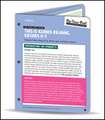 Preț: 88.67 lei
Preț: 88.67 lei -
 Preț: 147.92 lei
Preț: 147.92 lei -
 Preț: 273.44 lei
Preț: 273.44 lei -
 Preț: 245.73 lei
Preț: 245.73 lei -
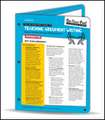 Preț: 88.67 lei
Preț: 88.67 lei -
 Preț: 236.13 lei
Preț: 236.13 lei -
 Preț: 209.16 lei
Preț: 209.16 lei -
 Preț: 256.83 lei
Preț: 256.83 lei -
 Preț: 291.05 lei
Preț: 291.05 lei -
 Preț: 288.67 lei
Preț: 288.67 lei -
 Preț: 273.44 lei
Preț: 273.44 lei -
 Preț: 278.11 lei
Preț: 278.11 lei -
 Preț: 244.08 lei
Preț: 244.08 lei -
 Preț: 244.45 lei
Preț: 244.45 lei -
![Mentor Texts That Multitask [Grades K-8]: A Less-Is-More Approach to Integrated Literacy Instruction](https://i3.books-express.ro/bs/9781071836132/mentor-texts-that-multitask-grades-k-8.jpg) Preț: 241.23 lei
Preț: 241.23 lei -
 Preț: 140.62 lei
Preț: 140.62 lei -
 Preț: 216.22 lei
Preț: 216.22 lei -
 Preț: 218.84 lei
Preț: 218.84 lei -
 Preț: 289.03 lei
Preț: 289.03 lei -
 Preț: 273.44 lei
Preț: 273.44 lei
Preț: 201.13 lei
Nou
Puncte Express: 302
Preț estimativ în valută:
38.49€ • 41.80$ • 32.33£
38.49€ • 41.80$ • 32.33£
Carte tipărită la comandă
Livrare economică 22 aprilie-06 mai
Preluare comenzi: 021 569.72.76
Specificații
ISBN-13: 9781483316291
ISBN-10: 1483316297
Pagini: 184
Dimensiuni: 216 x 279 x 15 mm
Greutate: 0.52 kg
Ediția:1
Editura: SAGE Publications
Colecția Corwin
Seria Corwin Literacy
Locul publicării:Thousand Oaks, United States
ISBN-10: 1483316297
Pagini: 184
Dimensiuni: 216 x 279 x 15 mm
Greutate: 0.52 kg
Ediția:1
Editura: SAGE Publications
Colecția Corwin
Seria Corwin Literacy
Locul publicării:Thousand Oaks, United States
Recenzii
“How
many
times
have
you
heard
‘a
picture
is
worth
a
thousand
words.’
Visual,
graphic
information
is
important
because
human
brains
are
hard-wired
to
attend
to
images.
The
challenge
is
that
students
still
have
to
read
words
to
achieve
success.
In
this
text,
Lapp,
Wolsey,
Wood,
and
Johnson
make
a
vital
connection
between
reading
words
and
the
role
of
graphics.
They
demonstrate
how
teachers
and
students
can
blend
the
two
such
that
great
learning
occurs
in
every
classroom,
every
day.”
“Lapp, Wolsey, Wood, and Johnson have written a book that will become the resource for using graphic organizers across disciplines! With careful attention to the details teachers crave in order to design meaningful lessons, the authors guide teachers on a journey that takes them far beyond the traditional uses of graphic organizers—jotting notes and organizing information—and show teachers how these visual tools lead students to independent thinking and inquiry, as well as support the Common Core reading and writing standards. What I love about this book is that it fosters original thinking among students as they design graphic organizers that enable them to unpack meaning from complex texts and develop arguments for essays.”
“Professional books have long urged teachers to use graphic organizers, but most of these books are dreadfully short on specifics. Diane Lapp and her colleagues have addressed this problem in an admirable fashion. They examine with care the kinds of organizers available to teachers, together with when and how to use them. And by showing how organizers transcend disciplinary boundaries, the authors pave the way for a school-wide focus for professional learning. Educators endeavoring to meet the challenges of the Common Core should mark this title as a must-read. This engaging book is long overdue and I recommend it enthusiastically!”
“For educators looking for ways to implement graphic organizers in their classrooms, this is the resource for you. The numerous types of graphic organizers, the research behind them, and the how and why to use them with students are all at your fingertips. I envision this book being especially helpful for teachers new to the field just learning about graphic organizers.”
“Lapp, Wolsey, Wood, and Johnson have written a book that will become the resource for using graphic organizers across disciplines! With careful attention to the details teachers crave in order to design meaningful lessons, the authors guide teachers on a journey that takes them far beyond the traditional uses of graphic organizers—jotting notes and organizing information—and show teachers how these visual tools lead students to independent thinking and inquiry, as well as support the Common Core reading and writing standards. What I love about this book is that it fosters original thinking among students as they design graphic organizers that enable them to unpack meaning from complex texts and develop arguments for essays.”
“Professional books have long urged teachers to use graphic organizers, but most of these books are dreadfully short on specifics. Diane Lapp and her colleagues have addressed this problem in an admirable fashion. They examine with care the kinds of organizers available to teachers, together with when and how to use them. And by showing how organizers transcend disciplinary boundaries, the authors pave the way for a school-wide focus for professional learning. Educators endeavoring to meet the challenges of the Common Core should mark this title as a must-read. This engaging book is long overdue and I recommend it enthusiastically!”
“For educators looking for ways to implement graphic organizers in their classrooms, this is the resource for you. The numerous types of graphic organizers, the research behind them, and the how and why to use them with students are all at your fingertips. I envision this book being especially helpful for teachers new to the field just learning about graphic organizers.”
Cuprins
Acknowledgments
Chapter 1. Graphic Organizers: Making the Complex Comprehensible
How to Think About Standards Alignment
How to Help Students Meet the Standards
Tips for Using Graphic Organizers Dynamically
How to Meet Eight Intertwined Academic Goals
What Lies Ahead in This Book
Chapter 2. Thinking on the Page: The Research Behind Why Graphic Organizers Work
Picture This: Visuals Quicken and Deepen Text Learning
General Tips: How to Use Graphic Organizers Well
Tiered Organizers: Scaffold Student Progress
Examples of Tiered Graphic Organizers
Adapting Graphic Organizers for Tiered Learning
A Sample Tiered Lesson
At-a-Glance Chart of Graphic Organizers Matched to Academic Goals
Chapter 3. Using Graphic Organizers to Acquire Academic Vocabulary
Frayer Organizer
Concept/Definition Map
Word Map
Chapter 4. Graphic Organizers Support Literary Text Reading and Writing Tasks
Character Graphic
Freytag’s Pyramid
Chapter 5. Graphic Organizers Support Informational Text Reading and Writing Tasks
Text Search and Find Board
4-Square With a Diamond
Modified KWL
Tabbed Book Manipulative
Chapter 6. Graphic Organizers Support Students’ Reading Proficiencies
Somebody-Wanted-But-So
Understanding Text Structures: Five Text Types
Chapter 7. Graphic Organizers Boost Questioning and Responding
I-Chart and I-Guide
Flip Chart Manipulative
Text-Dependent Question/Response Organizer
Chapter 8. Graphic Organizers Foster Reading, Forming, and Writing Opinions
Six-Part Opinion Organizer
Thinking Map
Chapter 9. Graphic Organizers Support Collaboration
Project Management Organizer
Conclusion
Appendix
Glossary
References
Index
Chapter 1. Graphic Organizers: Making the Complex Comprehensible
How to Think About Standards Alignment
How to Help Students Meet the Standards
Tips for Using Graphic Organizers Dynamically
How to Meet Eight Intertwined Academic Goals
What Lies Ahead in This Book
Chapter 2. Thinking on the Page: The Research Behind Why Graphic Organizers Work
Picture This: Visuals Quicken and Deepen Text Learning
General Tips: How to Use Graphic Organizers Well
Tiered Organizers: Scaffold Student Progress
Examples of Tiered Graphic Organizers
Adapting Graphic Organizers for Tiered Learning
A Sample Tiered Lesson
At-a-Glance Chart of Graphic Organizers Matched to Academic Goals
Chapter 3. Using Graphic Organizers to Acquire Academic Vocabulary
Frayer Organizer
Concept/Definition Map
Word Map
Chapter 4. Graphic Organizers Support Literary Text Reading and Writing Tasks
Character Graphic
Freytag’s Pyramid
Chapter 5. Graphic Organizers Support Informational Text Reading and Writing Tasks
Text Search and Find Board
4-Square With a Diamond
Modified KWL
Tabbed Book Manipulative
Chapter 6. Graphic Organizers Support Students’ Reading Proficiencies
Somebody-Wanted-But-So
Understanding Text Structures: Five Text Types
Chapter 7. Graphic Organizers Boost Questioning and Responding
I-Chart and I-Guide
Flip Chart Manipulative
Text-Dependent Question/Response Organizer
Chapter 8. Graphic Organizers Foster Reading, Forming, and Writing Opinions
Six-Part Opinion Organizer
Thinking Map
Chapter 9. Graphic Organizers Support Collaboration
Project Management Organizer
Conclusion
Appendix
Glossary
References
Index
Notă biografică
Descriere
Your
power
tools
for
making
the
complex
comprehensible
Now more than ever, our students are being asked to do highly advanced thinking, talking, and writing around their reading. If only there were ingenious new tools that could give our students the space to tease apart complex ideas in order to comprehend and weld their understandings into a new whole. Good news: these tools exist—Mining Complex Text. You’ll learn how graphic organizers can:
Now more than ever, our students are being asked to do highly advanced thinking, talking, and writing around their reading. If only there were ingenious new tools that could give our students the space to tease apart complex ideas in order to comprehend and weld their understandings into a new whole. Good news: these tools exist—Mining Complex Text. You’ll learn how graphic organizers can:
- Help students read, reread, and take notes on a text
- Promote students’ oral sharing of information and their ideas
- Elevate organized note-making from complex text(s)
- Scaffold students’ narrative and informational writing




